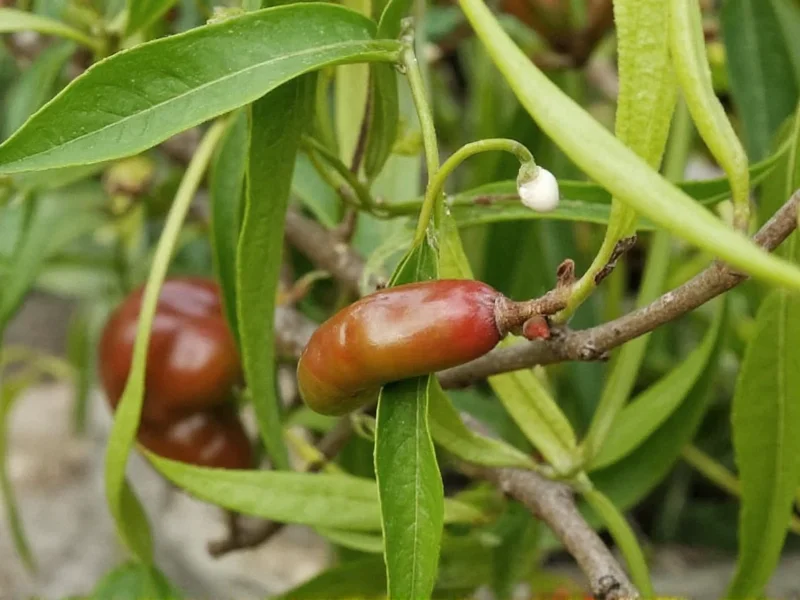The puya pepper (also called chile puya) is a thin, small dried chili pepper with a vibrant red color, moderate heat level of approximately 5,000 Scoville units, and a distinctive tangy, slightly fruity flavor profile featuring notes of berries and green tea. This Mexican culinary staple belongs to the same family as guajillo peppers but is smaller, thinner, and slightly hotter than its more common relative.
Understanding the unique characteristics of puya peppers can significantly enhance your cooking experience. These versatile dried chilies offer a complex flavor profile that's essential in many traditional Mexican dishes, from mole sauces to salsas. Unlike some hotter peppers that overwhelm with capsaicin, puya peppers provide balanced heat that complements rather than dominates other ingredients.
Origin and Botanical Background
Puya peppers come from the mirasol variety of Capsicum annuum, the same species that produces bell peppers, jalapeños, and guajillos. The name "puya" derives from the Nahuatl word "pōya," meaning "spiny" or "thorny," likely referring to the plant's growth characteristics. These peppers originated in Mexico and have been cultivated for centuries throughout central and southern regions of the country.
When fresh, puya peppers are long and slender, measuring approximately 4-6 inches in length. They start green and mature to a brilliant red before being harvested and sun-dried. The drying process concentrates their flavors and transforms their texture, making them ideal for grinding into powders or rehydrating for sauces.
Physical Characteristics and Flavor Profile
Puya peppers stand out with their distinctive appearance: thin walls, elongated shape (typically 3-5 inches long), and deep reddish-brown color when dried. Their thin skin makes them easier to rehydrate compared to thicker-walled peppers like ancho or mulato varieties.
| Characteristic | Puya Pepper | Guajillo Pepper |
|---|---|---|
| Size | 3-5 inches, thinner | 5-7 inches, wider |
| Heat Level | 4,000-5,000 SHU | 2,500-5,000 SHU |
| Flavor Notes | Tangy, berry, green tea | Floral, tea-like, berry |
| Wall Thickness | Thin | Moderate |
The flavor profile of puya peppers offers a complex balance that makes them valuable in Mexican cuisine. They provide moderate heat with pronounced tanginess, subtle berry notes, and a hint of green tea bitterness. This combination creates depth in sauces without overwhelming other ingredients. When properly toasted and rehydrated, they develop a rich, slightly smoky character that enhances both traditional and contemporary dishes.
Culinary Applications and Pairings
Chefs value puya peppers for their versatility in various cooking techniques. The most common preparation method involves toasting the dried peppers in a dry skillet for 20-30 seconds per side until fragrant, then soaking them in hot water for 15-20 minutes until softened. This rehydration process unlocks their full flavor potential.
Once prepared, puya peppers work exceptionally well in:
- Mole sauces - particularly regional variations from central Mexico
- Salsas rojas - where their tanginess provides bright contrast
- Adobo marinades - combined with vinegar and spices for meats
- Bean dishes - adding depth to refried beans or stews
- Stocks and broths - infusing subtle heat and flavor
When substituting puya peppers in recipes, consider the specific flavor elements you need. For heat and tanginess, guajillo peppers make the closest substitute, though they're slightly milder. For more pronounced berry notes, consider blending guajillo with a small amount of chipotle. Ancho peppers provide similar fruitiness but with less tang and more sweetness.
Availability and Storage Tips
Finding authentic puya peppers can be challenging outside of Mexico and specialty markets. Look for them in well-stocked Latin American grocery stores, particularly those with strong Mexican product selections. Online retailers specializing in Mexican ingredients often carry them, especially when searching for "chile puya" rather than "puya pepper. "
When selecting puya peppers, choose those with deep, uniform color and no signs of mold or excessive brittleness. Properly stored in an airtight container in a cool, dark place, they maintain quality for 6-12 months. For extended storage, keep them in the refrigerator or freezer, where they can last up to two years while preserving their flavor compounds.
Nutritional Benefits
Like other chili peppers, puya peppers contain capsaicin, which has been studied for potential metabolic and anti-inflammatory benefits. They're also rich in vitamin C (especially when fresh), vitamin A precursors, and various antioxidants. The drying process concentrates some compounds while reducing others, but the resulting product remains nutritionally valuable when used as part of a balanced diet.
One notable characteristic of puya peppers is their relatively high concentration of certain phenolic compounds that contribute to their distinctive flavor profile. These compounds may offer additional health benefits, though research specifically on puya peppers remains limited compared to more widely studied chili varieties.











 浙公网安备
33010002000092号
浙公网安备
33010002000092号 浙B2-20120091-4
浙B2-20120091-4